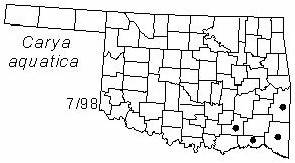Description: Tree to 20 m (65 ft) tall and 30 cm (12 in) diameter, with narrow crown. Bark light brown, becoming fissured into long platelike scales on older trunks and branches. Twigs slender, dark brown. The single terminal bud is brown, usually hairy, narrow, with paired scales not overlapping. Leaves alternate, pinnately compound, 23-38 cm (9-15 in) long, with a dark red hairy rachis. Leaflets usually 11-13, lanceolate, 5-13 cm (2-5 in) long, usually slightly sickle-shaped, acuminate, finely serrate, glabrous dark green above, paler and sometimes hairy below. Flowers catkins appearing in the early spring. Fruits flattened, 2.5-4 cm (1-1.6 in) long, 4-winged, with a thin husk.
Distribution: The species is native to the Coastal Plain of southeastern United States.
Habitat: stream banks and wet soil of floodplains in southeastern Oklahoma.
NWI status: OBL
Comment: The nuts of all the hickories are important food for wildlife, especially squirrels. The seeds of eater hickory are bitter and are not eaten by people. Carya is the ancient Greek name for walnut; aquatica refers to the wet habitat of the species.
Distribution in Oklahoma: 
BACK
NEXT
RETURN TO INDEX
Last update: 9/8/99
 Go to Oklahoma Biological Survey Home Page
Go to Oklahoma Biological Survey Home Page
 Disclaimer
Disclaimer